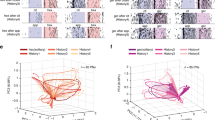Abstract
The spatial pattern of EEG activity at the surface of the olfactory bulb tends to be invariant with respect to input and to change to a new pattern whenever an animal is trained to expect or search for a particular odor. It is postulated here that the spatial EEG pattern is dependent on a neural template for that odor that is formed during training. This hypothesis is expressed in the form of a model consisting of an array of interconnected elements (1x10 or 6x6). Each element represents 2 excitatory and 2 inhibitory subsets of neurons with 3 types of internal feedback: negative, mutually excitatory, and mutually inhibitory. The elements are interconnected only by mutual excitation and mutual inhibition. Each neural subset is represented by a nonlinear differential equation; the connections are represented by modifiable coupling coefficients. With appropriate values of the time, coupling, and gain coefficients, and with input that is modelled on olfactory input, the set of 40 or 144 equations gives output that simulates the time and space patterns of the EEG.
In the naive state the coefficients are uniform. A template is formed by giving input to selected elements, cross-correlating the outputs, and weighting the mutually excitatory coupling coefficient between each pair of elements by the corresponding correlation coefficient. When a template has been formed, input to nontemplate elements is treated as noise. Optionally a matched filter is made to simulate habituation by reducing the synaptic gain coefficients of those excitatory subsets that receive the noise. The model is tested by giving input to nontemplate elements and to none, part or all of the template elements.
There are two outputs of the model. One is the spatial pattern V j of the root mean square (rms) amplitudes of the individual outputs v(j,t) of the elements. The other output is the rms amplitude E rms of the ensemble average E(t) over v(j, t).
The results show that V j depends on the template and is relatively insensitive to input, whether or not input is given to template elements. However, E rms increases in proportion to the number of “hits” on the template. If the number of elements receiving noise does not exceed the number of elements in a template, or if the noise is matched with a habituation filter, then E rms rises above the noise level for a “hit” on any one or more template elements irrespective of location or combination.
V j conforms to the performance of the surface EEG. E rms is not yet accessible to physiological measurement.
Similar content being viewed by others
References
Babloyantz, A., Kaczmarek, L.K.: Self-organization in biological systems with multiple cellular contacts. Bull. Math. Biol. 41, 193–201 (1979)
Brindley, G.S.: Nerve net models of plausible size that perform many simple learning tasks. Proc. R. Soc. London. Ser. B 174, 173–191 (1969)
Freeman, W.J.: Mass action in the nervous system. New York: Academic Press 1975
Freeman, W.J.: Spatial properties of an EEG event in the olfactory bulb and cortex. Electroencephalogr. Clin. Neurophysiol. 44, 586–605 (1978a)
Freeman, W.J.: Spatial frequency analysis of an EEG event in the olfactory bulb. In: Multidisciplinary perspectives in eventrelated brain potential research. Otto, D.A. (ed.), pp. 533–542. U.S. Government Printing Office EPA-600/9-77-043, Washington, D.C. 1978b
Freeman, W.J.: Models of the dynamics of neural populations. Electroencephalogr. Clin. Neurophysiol. [EEG Suppl. No. 34] 9–18 (1978c)
Freeman, W.J.: Nonlinear gain mediating cortical stimulus-response relations. Biol. Cybernetics 33, 237–247 (1979)
Freeman, W.J.: Nonlinear dynamics of paleocortex manifested in the olfactory EEG. Biol. Cybernetics 35, 21–37 (1979b)
Freeman, W.J.: A software lens for image reconstitution of the EEG. In: Motivation, motor and sensory processes of the brain: Electrical potentials, behavior and clinical use. Kornhuber, H.H., Deecke, L. (eds). Progr. Brain Res. (1980)
Lashley, K.S.: In search of the engram. Symp. Soc. Exp. Biol. 4, 454–482 (1950)
Shepherd, G.M.: Synaptic organization of the mammalian olfactory bulb. Physiol. Rev. 52, 864–917 (1972)
Sunday, D.M., Freeman, W.J.: Nonlinear coupling of wave and pulse activity in a neural mass. Physiologist 18, 42 (1975)
Uttley, A.M.: A two-pathway informon theory of conditioning and adaptive pattern recognition. Brain Res. 102, 23–35 (1976)
Willey, T.J.: The ultrastructure of the cat olfactory bulb. J. Comp. Neurol. 152, 211–232 (1973)
Author information
Authors and Affiliations
Additional information
Supported by a grant MH 06686 from the National Institute of Mental Health and by a Research Professorship from the Miller Institute, Berkeley.
Rights and permissions
About this article
Cite this article
Freeman, W.J. EEG analysis gives model of neuronal template-matching mechanism for sensory search with olfactory bulb. Biol. Cybernetics 35, 221–234 (1979). https://doi.org/10.1007/BF00344205
Received:
Issue Date:
DOI: https://doi.org/10.1007/BF00344205




